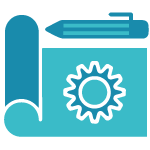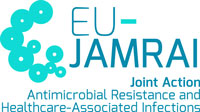Step by step guide for the implementation and assessment of Service Learning
Service Learning (SL) is a structured experiential education pedagogy that intentionally integrates meaningful community service with academic instruction, critical reflection, and civic responsibility to enrich the learning experience, achieve specific AMR/AMS learning objectives, address genuine community-identified needs, and foster reciprocal benefits for both learners (students or professionals) and the community partners. Unlike volunteering, SL is distinguished by its deliberate curricular connections, emphasis on reciprocal partnerships, and the central role of structured reflection in deepening understanding and linking service experiences to academic content and personal/professional development

Planning a Service Learning
The following steps should be taken into consideration when planning a Service Learning experience on AMR/AMS:
- Establish Reciprocal Community Partnerships and Identify Genuine AMR/AMS Needs: Develop strong, collaborative, and respectful partnerships with community organizations, local health departments, schools, agricultural groups, patient advocacy groups, or other relevant stakeholders. Work together to identify genuine community needs related to AMR awareness, prevention, or stewardship that can be addressed through an SL project. Define mutually beneficial goals and expectations for the project. (Aramburuzabala and Cerrillo, 2023, emphasize the importance of collaboration and partnership).
- Integrate Service with AMR/AMS Curriculum and Define Learning Objectives: Clearly link the planned service activities to specific academic learning objectives within an AMR/AMS course or training program. Ensure that the service will provide opportunities for learners to apply theoretical knowledge, develop relevant skills, and gain a deeper understanding of AMR/AMS in a real-world context. (Valderrama et al., 2018, adapted the Small World Initiative for AMR awareness as an SL project with defined learning goals).
- Thorough Participant Preparation: Equip learners (e.g., health science students, professionals in continuing development) with the necessary background knowledge on the specific AMR/AMS issues they will address, relevant skills (e.g., health education techniques, culturally sensitive communication, data collection methods for community assessment), a clear understanding of the community context and its culture, and important ethical considerations (e.g., confidentiality, informed consent, power dynamics) before they begin their service. (Glòria et al., 2022, describe a training phase for nursing students before they conduct health education workshops as part of SL).
- Design and Implement Meaningful Service Activities: Co-design and implement service activities that directly address the identified AMR/AMS community need and provide rich opportunities for learners to apply their knowledge, develop professional competencies, and contribute positively to the community. Examples include: developing and delivering AMR/AMS awareness workshops for specific community groups (Valderrama et al., 2018; Aryzki et al., 2024, on environmental sanitation education; Glòria et al., 2022, on health habits), creating culturally appropriate educational materials on prudent antibiotic use, assisting community health workers with AMR-related outreach, or supporting local initiatives for infection prevention and control.
- Integrate Structured and Ongoing Reflection: Facilitate structured reflection activities before, during, and after the service experience. Reflection is critical for helping learners analyze their experiences, connect service activities to academic AMR/AMS concepts, critically examine social issues and determinants related to AMR, understand community perspectives, and consider their personal, professional, and civic growth. Reflection methods can include guided journaling, critical incident reports, group discussions, presentations, and portfolio development. (Schmidt et al., 2016, and Dombrowsky et al., 2019, Source: 260236) highlight reflection as a core component of SL).
- Ensure Community Voice, Reciprocity, and Recognition: Continuously engage community partners throughout the project to ensure their perspectives are valued, the service remains beneficial, and collaborative decisions are made. Formally recognize the contributions of both learners and community partners.
- Evaluation and Dissemination: Evaluate the impact of the SL project on student learning, community outcomes related to AMR/AMS, and the strength of the partnership. Share findings with stakeholders.

Defining roles in a Service Learning
Facilitator’s role (Educator/Program Coordinator): Identify and cultivate strong, ethical, and reciprocal community partnerships. Co-design SL projects in collaboration with community partners and learners, ensuring alignment with AMR/AMS learning objectives. Integrate the SL experience meaningfully into the curriculum. Thoroughly prepare and mentor learners throughout the process. Design and guide effective structured reflection activities to deepen learning. Ensure ethical conduct, safety, and risk management. Mediate relationships and troubleshoot challenges. Lead the evaluation of the SL project’s impact on all stakeholders.
Participant’s role (Learner): Actively participate in all phases of the SL project: preparation, direct service, and structured reflection. Apply academic AMR/AMS knowledge and professional skills to serve identified community needs. Interact respectfully, ethically, and with cultural humility with community members and partners. Engage thoughtfully and critically in reflection activities to connect service experiences with learning objectives, understand broader social and contextual factors influencing AMR, and develop civic awareness, professional competencies, and a commitment to social responsibility.

Assessing a Service Learning
Methods
- Reflective Outputs: Assessment of learners’ reflective journals, essays, blogs, presentations, or portfolios, focusing on the depth of critical thinking, connection of service experiences to AMR/AMS academic content, understanding of community issues, and evidence of personal/professional/civic growth. (Glòria et al., 2022, used qualitative analysis of students’ reflective narratives).
- Project Deliverables: Evaluation of tangible outputs from the service project (e.g., quality and appropriateness of AMR awareness materials developed, effectiveness of educational workshops delivered, reports on community engagement activities or data collected).
- Feedback from Community Partners: Soliciting formal and informal feedback from community partners regarding the value, quality, and impact of the service provided by the learners, as well as the quality of the partnership.
- Pre- and Post-Service Assessments: Measuring changes in learners’ AMR/AMS knowledge, specific skills (e.g., communication, health education delivery, interprofessional teamwork if SL is team-based), attitudes towards civic engagement or underserved communities, cultural competence, and understanding of social determinants of health related to AMR. (Aryzki et al., 2024, used pre-post tests to evaluate knowledge improvement in community members receiving SL intervention; similar principles apply to assessing student learning).
- Learner Satisfaction and Perceived Learning: Surveys or focus groups to assess learners’ satisfaction with the SL experience, its perceived contribution to their learning and professional development, and its impact on their understanding of AMR/AMS in a community context. (García Garcés et al., 2021, Source: 261124, specifically assessed student satisfaction with SL methodology).
Tools
Rubrics for assessing reflective assignments and project deliverables. Standardized or custom-developed community partner feedback forms or interview guides. Validated scales for measuring constructs like civic attitudes, cultural competence, empathy, or specific AMR-related knowledge and attitudes. Pre-post knowledge tests. Student satisfaction questionnaires. Portfolios documenting the SL process and outcomes.

Suggested Service Learning prototype
Target Audience: Clinical Profiles (nursing, pharmacy, medical students/trainees), Researchers (especially those in public health, epidemiology, social sciences), Educators (those training future health professionals or community educators). (The literature shows wide application of SL in health sciences education, as Dombrowsky et al., 2019, Glòria et al., 2022, Ruiz-Montero et al., 2019, Valderrama et al., 2018, involved university students from diverse health and science fields in an AMR awareness SL project, aligning with a One Health approach).
Learning Objectives:
- For Learners:
- Apply One Health principles to understand and address a specific, local AMR-related issue in collaboration with community partners.
- Develop skills in community assessment, project design, interprofessional collaboration (if working in teams), and culturally appropriate communication for AMR awareness and behavior change.
- Enhance understanding of the social, economic, and environmental determinants that contribute to AMR in the target community.
- For Community:
- Increase awareness of specific AMR risks and promote the adoption of positive behaviors related to prudent antibiotic use, hygiene, or relevant environmental practices.
Curriculum/Activities:
- Phase 1: Preparation and Partnership (Academic Setting and Community):
- Learners (e.g., interprofessional teams of students from medicine, veterinary medicine, public health, environmental science) receive academic instruction on One Health, AMR mechanisms, local AMR challenges, community engagement principles, and project management skills.
- In collaboration with a community partner (e.g., a local primary school, a group of small-scale farmers, a community health clinic), learners conduct a rapid needs assessment to identify a specific, manageable AMR-related issue (e.g., poor understanding of antibiotic use for common colds among parents, overuse of antibiotics in a specific livestock practice, gaps in hygiene knowledge related to infection prevention).
- Phase 2: Project Co-Design and Planning (Academic Setting and Community):
- Learners, with guidance from faculty and community partners, co-design a targeted intervention (e.g., develop and deliver interactive workshops for parents on responsible antibiotic use; create and distribute educational materials on biosecurity for farmers; implement a hand hygiene promotion campaign in a school). (Valderrama et al., 2018, describe students preparing materials and activities for AMR awareness in schools).
- Phase 3: Service Implementation (Community Setting):
- Learners implement their co-designed AMR/AMS intervention in the community, working closely with the community partner.
- Phase 4: Reflection and Evaluation (Academic Setting and Community):
- Throughout the project, learners engage in structured reflection (e.g., weekly journals, group debriefing sessions) on their experiences, challenges, successes, and learning.
- At the project’s conclusion, learners present their project outcomes, reflections, and lessons learned to peers, faculty, and community partners.
- Joint evaluation of the project’s impact on both student learning and community outcomes related to AMR/AMS.
Evaluation of the Prototype’s Effectiveness:
- Assessment of the quality and impact of the community-based AMR intervention (e.g., pre-post knowledge/attitude surveys among community members targeted by the intervention, as in Aryzki et al., 2024).
- Evaluation of learners’ reflective assignments for depth of critical thinking, integration of One Health and AMR/AMS concepts, and understanding of community dynamics.
- Feedback from community partners on the value of the service, the professionalism of the learners, and the quality of the collaborative relationship.
- Assessment of changes in learners’ knowledge of One Health AMR issues, their skills in community engagement and interprofessional collaboration, and their civic attitudes or sense of social responsibility.
- Learner satisfaction with the overall SL experience and its contribution to their professional development in AMR/AMS.
References
- Aramburuzabala, P., & Cerrillo, R. (2023). Service-Learning as an Approach to Educating for Sustainable Development. Sustainability, 15(14), 11231. https://doi.org/10.3390/su151411231
- Aryzki, S., Ayuchecaria, N., & Sari, A. K. (2024). Improving Environmental Sanitation Knowledge through Clean and Healthy Living Behavior (CHLB) Education. Bubungan Tinggi: Jurnal Pengabdian Masyarakat, 6(2), 407. https://doi.org/10.20527/btjpm.v6i2.10816
- Dombrowsky, T., Gustafson, K., & Cauble, D. (2019). Service-Learning and Clinical Nursing Education: A Delphi Inquiry. Journal of Nursing Education, 58(7), 381–391. https://doi.org/10.3928/01484834-20190614-02
- García Garcés, L., Ruiz-Zaldibar, C., Gerónimo Llopis, Á., Vicario Merino, Á., & Lluesma Vidal, M. (2021). Student satisfaction with the Service-Learning methodology: An added value in the training of the nursing degree. Horizonte Sanitario, 21(1). https://doi.org/10.19136/hs.a21n1.4511
- Glòria, R.-G., David, C.-L., Malagón-Aguilera, M. C., Pérez-Jiménez, B., Mantas-Jiménez, S., & Roqueta-Vall-llosera, M. (2022). Service Learning Experience on Health Habits in High School Students Conducted by Nursing Students: A Qualitative Design. Nursing Reports, 12(4), 804–813. https://doi.org/10.3390/nursrep12040078
- Hernández-Barco, M., Sánchez-Martín, J., Blanco-Salas, J., & Ruiz-Téllez, T. (2020). Teaching Down to Earth—Service-Learning Methodology for Science Education and Sustainability at the University Level: A Practical Approach. Sustainability, 12(2), 542. https://doi.org/10.3390/su12020542
- Martín-Sánchez, A., González-Gómez, D., & Jeong, J. S. (2022). Service Learning as an Education for Sustainable Development (ESD) Teaching Strategy: Design, Implementation, and Evaluation in a STEM University Course. Sustainability, 14(12), 6965. https://doi.org/10.3390/su14126965
- Mason, M. R., & Dunens, E. (2019). Service-Learning as a Practical Introduction to Undergraduate Public Health: Benefits for Student Outcomes and Accreditation. Frontiers in Public Health, 7, 63. https://doi.org/10.3389/fpubh.2019.00063
- Robredo, B., Fernández-Fernández, R., & Torres, C. (2021). Antimicrobial resistance as a nexus between teaching and research. Journal of Biological Education, 57(4), 856–872. https://doi.org/10.1080/00219266.2021.1979631
- Robredo, B., Fernández-Fernández, R., Torres, C., & Ladrera, R. (2023). MicroMundo: Experimental project fostering contribution to knowledge o n antimicrobial resistance in secondary school. FEMS Microbiology Letters, 370, fnad010. https://doi.org/10.1093/femsle/fnad010
- Ruiz-Montero, P.-J., Chiva-Bartoll, O., Salvador-García, C., & Martín-Moya, R. (2019). Service-Learning with College Students toward Health-Care of Older Adults: A Systematic Review. International Journal of Environmental Research and Public Health, 16(22), 4497. https://doi.org/10.3390/ijerph16224497
- Schmidt, S., George, M., & Jones, J. B. (2016). Welcome to the Neighborhood: Service Learning to Understand of Social Determinants of Health and Promote Local Advocacy. Diversity & Equality in Health and Care, 13(6). https://doi.org/10.21767/2049-5471.100081
- Silverberg, S. L., Zannella, V. E., Countryman, D., Ayala, A. P., Lenton, E., Friesen, F., & Law, M. (2017). A review of antimicrobial stewardship training in medical education. International Journal of Medical Education, 8, 353–374. https://doi.org/10.5116/ijme.59ba.2d47
- Valderrama, M. J., González-Zorn, B., de Pablo, P. C., Díez-Orejas, R., Fernández-Acero, T., Gil-Serna, J., de Juan, L., Martín, H., Molina, M., Navarro-García, F., Patiño, B., Pla, J., Prieto, D., Rodríguez, C., Román, E., Sanz-Santamaría, A. B., de Silóniz, M. I., Suárez, M., Vázquez, C., & Cid, V. J. (2018). Educating in antimicrobial resistance awareness: Adaptation of the Sma ll World Initiative program to service-learning. FEMS Microbiology Letters, 365(17), fny161. https://doi.org/10.1093/femsle/fny161
